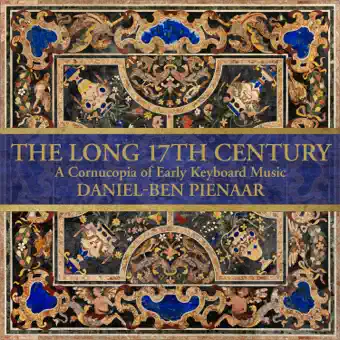juni 2020
The Long 17th Century: A Cornucopia of Early Keyboard Music
Daniel-Ben Pienaar
Net als de beste mensen die oude muziek op piano uitvoeren, laat Daniel-Ben Pienaar deze stukken – en wat een genereus offer geeft hij ons – leven en ademen met een bijna hedendaagse gevoeligheid.

Daniel-Ben Pienaar, die duidelijk niet van half werk houdt, biedt hier niet één cd met vroege klaviermuziek op de piano aan, maar twee. Dat zijn in totaal 36 stukken van in totaal 36 componisten, waarvan sommigen zelfs voor klavecinisten en organisten moeilijk te identificeren zijn. Dit is geen man die zich verdiept in het 'niet-piano'-repertoire, maar iemand die zich erin verdiept en met vertrouwen selecteert.
Wat het laat werken, is niet alleen de oogverblindende precisie en helderheid van Pienaars vingertechniek (hoewel dat zeker een essentiële factor is), maar de intelligentie die in zijn interpretaties is gestoken. Pienaar bevindt zich in het gezelschap van hedendaagse pianisten die, hoewel ze oude muziek respecteren, deze zien als ruw materiaal voor de pianistische verbeelding – soortgelijke avontuurlijke zielen zijn Alexandre Tharaud, Francesco Tristano en Joanna MacGregor – maar het lijdt geen twijfel dat hij ook werkt vanuit een positie van diepe kennis van de oorspronkelijke omstandigheden van de muziek. Busoni zei ooit dat elke compositie een werk van transcriptie is, en cruciaal is dat Pienaar zijn besef dat veel van deze muziek mogelijk buiten het klavier is ontstaan (als een luitsolo misschien, of een viola da gambaconsort) laat meespelen in zijn interpretaties – luister naar de prachtige manier waarop de kleuren aanzwellen en veranderen als een blaasorkest in Gabrieli’s Canzon quarta. Hij bereikt dit alles door niet bang te zijn om de middelen van de piano te gebruiken, zoals dynamische gradatie, lijndifferentiatie, reactiesnelheid en heel discreet pedaalwerk, gekoppeld aan zijn eigen allesomvattende variaties van kleur en aanslag (zo netjes gebeiteld in Weckmanns Canzon, zo liefdevol gedempt in Philips’ Pavan) om de muziek te injecteren met elementen die niet haalbaar zouden zijn geweest op klavecimbel of orgel. Zo durft hij Kerlls Passacaglia meer ruimte tussen de noten te geven dan je normaal zou verwachten, of de afgevuurde kruisritmes in Bulls Ut, re, mi, fa, sol, la te benadrukken op een manier die geen klavecimbel had gekund. Hij creëert ook een aantal indrukwekkende climaxen, bijvoorbeeld in Cabanilles’ Passacalles.
Pienaar zelf beschrijft zijn aanpak als een van ‘opzettelijk verkeerd lezen’; maar hoewel het brede scala aan onthulde stemmingen verrassend kan zijn – Frescobaldi’s Toccata cromaticha is pijnlijk inwendig en meditatief; Sweelincks Mein junges Leben hat ein End krijgt een lyrische, bijna Engelse pastorale sfeer; Braga’s Batalha lekt een Beethoveniaanse energie – zou het moeilijk zijn om te zeggen dat de muziek hier ernstig verkeerd wordt voorgesteld door wat Pienaar ermee doet. Niet alleen dat; hij communiceert ook een individuele en overtuigende visie voor elk stuk, genoeg voor elk van hen om te genieten. Briljant.

Clearly not one to do things by halves, Daniel-Ben Pienaar – whose releases already include the complete Beethoven sonatas and the Bach ‘48’ – offers here not just one disc of early keyboard music on the piano but two. That’s a total of 36 pieces, by a total of 36 composers, some of whom even harpsichordists and organists might be hard-put to identify. This is not a man dabbling in the ‘non-piano’ repertoire but one immersing himself in it and selecting with confidence.
What makes it work is not just the dazzling precision and clarity of Pienaar’s finger technique (though that is certainly a vital factor), but the intelligence that has gone into his interpretations. Pienaar is in the company of modern-day pianists who, while respecting early music, see it as raw material for the pianistic imagination – similar adventurous souls include Alexandre Tharaud, Francesco Tristano and Joanna MacGregor – but there is no doubt that he also works from a position of deep knowledge of the music’s original circumstances. Busoni once said that any composition is a work of transcription, and crucially Pienaar allows his awareness that much of this music may have started life away from the keyboard (as a lute solo perhaps, or a viol consort) to inform his interpretations – listen to the gorgeous way the colours swell and switch like a wind band in Gabrieli’s Canzon quarta. He achieves all this by not being afraid to use the piano’s resources of dynamic gradation, differentiation of line, quickness of response and some very discreet pedalling, coupled with his own all-encompassing varieties of colour and touch (so neatly chiselled in Weckmann’s Canzon, so lovingly cushioned in Philips’s Pavan) to inject the music with elements that would not have been achievable on harpsichord or organ. Thus he can dare to give Kerll’s Passacaglia more space between the notes than one would normally expect, or emphasise the fired-off cross-rhythms in Bull’s Ut, re, mi, fa, sol, la in a way no harpsichord could have managed. He shapes some impressive climaxes, too, for instance in Cabanilles’s Passacalles.
Pienaar himself describes his approach as one of ‘deliberate misreading’; but while the wide range of moods revealed can be surprising – Frescobaldi’s Toccata cromaticha is achingly inward and meditative; Sweelinck’s Mein junges Leben hat ein End acquires a lyrical, almost English pastoral feel; Braga’s Batalha leaks a Beethovenian energy – it would be hard to say that any of the music here is seriously misrepresented by what Pienaar does with it. Not only that; he also communicates an individual and convincing vision for each piece, enough for every one of them to give delight. Brilliant.
